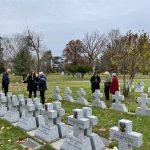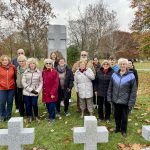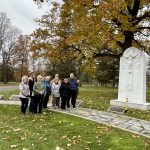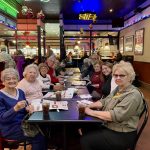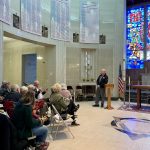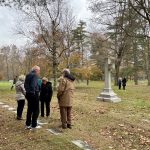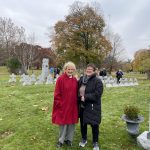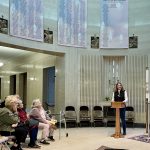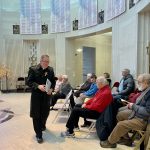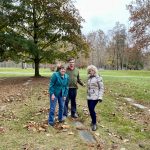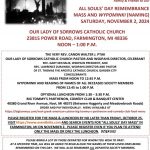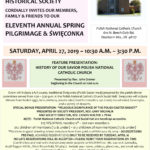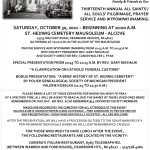SOCIETY HOLDS FIFTEENTH ANNUAL ALL SAINTS’/ALL SOULS’ PILGRIMAGE, PRAYER SERVICE & WYPOMINKI (NAMING):
HOLY SEPULCHRE CEMETERY, SOUTHFIELD, MICHIGAN
SATURDAY, NOVEMBER 4, 2023
Photos by Society Director Alina Klin, Ph.D. and
Society Member David S. Rhine
Twenty-nine pilgrims were in attendance at the Society’s Fifteenth Annual All Saints’/All Souls’ Pilgrimage, Prayer Service & Wypominki (Naming) this year. It was wonderful to see such a large turnout for what has always been one of the Society’s most cherished events.
We gathered at noon in the beautiful Rotunda Chapel inside the cemetery’s main mausoleum. A somber but serene atmosphere prevailed as the names of the departed during the past year were listed on large scrolls and hung high above us around the dome of the mausoleum. The cemetery was also preparing for its Night of Lights Luminary Remembrance that evening from 4:00 to 8:00 p.m. Luminaria candle bags, with unlit candles inside them, lined the long hallways of the mausoleum, waiting to be lit up. It was a beautiful sight and one of anticipation and hope.
Everyone who attended also had the opportunity to adorn a glass ornament with the name of a dearly departed loved one to be hung on the cemetery’s Christmas tree.
Our president, Rev. Gary Michalik, led the Prayer Service, along with our director, Rev. Lawrence Zurawski. Director Rev. Canon Walter J. Ptak was unable to join us due to celebrating a funeral in Wyandotte. We missed his bellowing voice during the opening and closing hymns, as most of us are shy about singing in public. However, we were blessed to have Sr. Mary Andrew Budinski, C.S.S.F., join us. Sr. Andrew is a member of the religious community known as the Felician Sisters of North America, Our Lady of Hope Province, and she ministers at St. Therese of Lisieux Catholic Church in Shelby Township, Michigan, serving seniors and the homebound. Sr. Andrew graciously led us in singing the opening and closing hymns.
Our featured presenter at this event was Dr. John Radzilowski, Director of the Polish Institute of Culture and Research at Orchard Lake. He talked about the men who volunteered to serve in General Józef Haller’s Blue Army, a Polish military group formed in France during the later stages of World War I. The army got their name because of their blue uniforms, which were French-issued military uniforms.
Also in attendance at this event was Mrs. Henrietta Nowakowski of Dearborn Heights, whose lifelong research efforts on the subject of the Haller’s Army volunteers led to the discovery of those buried in Section 5 of Holy Sepulchre Cemetery. She diligently pursued their recognition and honor.
Dr. Radzilowski told us that he began his career many years ago by writing obituaries for a newspaper in Minnesota. His editor told him that it would be the most important job he would ever have because for most of the people he was writing about, it would be the only time they would ever have their names printed in the newspaper. He took his position and what it required of him to heart.
He spoke to us about the hidden lives of the men who volunteered for General Haller’s Blue Army, stating that he wanted to write the stories of the volunteers. There were several researchers involved in the project.
They found quite a bit of information on some of the volunteers. On others, they had very little information. Some of the stories were sad. But Dr. Radzilowski wanted to provide a level of dignity by saying their names and telling their stories.
He told us that after World War I, Detroit was an important area for recruitment, as were Chicago and Buffalo. The soldiers of Haller’s Army went first to the western front in France, and then to Germany. Afterwards, they went to help Poland regain its independence in the Polish-Bolshevik War.
After the war, Poland had regained its independence, but it was a very poor country. It was ravaged by the war. Starvation and epidemics were rampant. It had been American aid that had helped save the lives of countless people under the Hoover administration. However, Hoover was not a good president.
After the war, some soldiers came back, but others didn’t. Many of those who returned had injuries. It was very difficult for them to adjust to the life that they once knew. A lot of the men who volunteered with the Blue Army were new to the United States before they went off with the Blue Army. Many worked as laborers in factories. A few were married, but some married when they returned from the war.
Many of the men didn’t have support systems. A lot of the men struggled. Some of them had been gassed during service. They suffered from influenza, cholera, and malaria. Because of their injuries, they weren’t able to re-establish a life. They didn’t have a lot of connections in America. This was the beginning of what would become Section 5 in Holy Sepulchre Cemetery in what is today Southfield, Michigan.
It was the Ladies Auxiliary Post No. 5 of the Polish Army Veterans Association in America (SWAP) who put together the aid for the men. It was the women who did this by putting on events to raise money for them.
In addition to not having a support system and having to struggle against injury and disease, the men also didn’t receive any benefits. There was no G.I. Bill. Even the American veterans struggled, but the Polish veterans also didn’t have any benefits from Poland unless they stayed in Poland. It wasn’t until 1939 that the Polish government was ready to disburse benefits, but by then World War II had broken out. This led to the purchase of Section 5 for a proper, dignified burial place for the volunteers of Haller’s Army. The Ladies Auxiliary bought Section 5 for this purpose.
Some of the graves had grave markers, and some didn’t. It depended a lot on the family. But some didn’t have family.
Henrietta Nowakowski began researching this. Her father was in the veterans’ group, and her mother was in the women’s group. Eventually, she got the right people involved at Orchard Lake and started working with the Institute for National Remembrance in Poland, which assisted with providing the grave markers. The grave markers were created in Poland and shipped to Holy Sepulchre Cemetery via Canada.
Representatives across the United States and Canada took part in the dedication ceremony at the cemetery on June 17, along with Their Excellencies Archbishop Allen H. Vigneron and Bishop Robert Fisher, Rev. Bernard Witek, SDS, representatives of the Polish and Canadian governments, and current and retired members of the Polish and American Armed Forces. The contributions of the staffs of Holy Sepulchre Cemetery and the Archdiocese of Detroit were invaluable.
Our event on November 4 continued with distributing samples of soul cakes to all pilgrims present. Soul cakes are small cookie-like cakes seasoned with fall spices and which, in early times, were similar to hot cross buns without the currants or the cross on top. Children in the nineteenth and twentieth centuries would go “souling,” similar to caroling, requesting alms, or soul cakes.
Our treasurer, Barb Gamble, then made an exciting announcement that was relevant since it involved a World War I U.S. Army veteran buried at St. Hedwig Cemetery. Barb is the creator and keeper of a database of Polish veterans buried at St. Hedwig Cemetery, and in 2021, during the annual Wreaths Across American event at the cemetery, she identified a veteran buried there, Joseph Frank Bigos, whose grave didn’t have a marker. Veteran Bigos is buried in Section 1, Lot 2, Grave 287 in the old section of the cemetery.
That began a two-year mission to obtain a headstone for veteran Bigos’ grave. Barb learned that veteran Bigos died at Veterans Hospital in Allen Park. She attempted to procure a marker through the Department of Veterans Affairs, but since veteran Bigos was born in Poland, there were obstacles involved in procuring the grave marker through the VA due to not having the necessary paperwork.
Contact was made with Inch Memorials in Northville to determine if there were any granite slab remnants that might be sold at a discount. Mr. Greg Grinnell, Production Supervisor at Inch Memorials, was able to convince his boss to donate the headstone. Mr. Grinnell’s grandfather was a World War I veteran, so this initiative was near to his heart. He then contacted the grounds manager at St. Hedwig Cemetery to see if the cemetery might be able to donate the cost of the installation of the headstone. Through the generous efforts of Mr. David A. Zielinski, Director of Operations at St. Hedwig Cemetery, the installation cost was waived, and veteran Bigos’ grave now has a proper military headstone.
Barb’s announcement was fitting, as it seemed to us that this was the year of the veteran and the year of remembrance of all veterans. The Society plans to hold an event commemorating the placement of veteran Bigos’ grave marker sometime in 2024. We will, of course, keep our members apprised of the plans for this event.
The pilgrims then processed by car to the Haller’s Army section of Holy Sepulchre Cemetery, first to visit the Haller’s Army graves and monument in Section 5. It was moving to observe the grave markers, to read the men’s names etched in the stone markers, to reflect upon what the men had sacrificed and what they had endured when they returned from the war, and to realize that they had gone for so many years unrecognized and unappreciated. We lit the first of three remembrance candles at one of the Haller’s Army graves.
As we also were observing Clergy Appreciation Month, we processed to the Archbishop’s Circle, where we lit a second remembrance candle.
The third stop on our pilgrimage was to the Felician Sisters’ section of the cemetery, where we lit a third and final remembrance candle.
By that time, the pilgrims had become weary and hungry, so we headed to our pre-planned luncheon at Shield’s Pizza on Telegraph Road and Ten Mile Road, not far from the cemetery. There we enjoyed delicious food, warmth, and camaraderie.
We’re grateful to Ms. Deanna Cortese of the Archdiocese of Detroit who helped coordinate this event with Holy Sepulchre Cemetery and to the cemetery office staff, who provided us with maps so that we could easily navigate through the cemetery. We appreciate the warm welcome by Ms. Patricia Kade of Holy Sepulchre Cemetery, who made sure we had everything we needed. And we’re immensely grateful to Dr. John Radzilowski for his presentation and all his efforts to preserve the memories of the volunteers of Haller’s Army. Of course, Mrs. Henrietta Nowakowski’s years of research made it possible.
